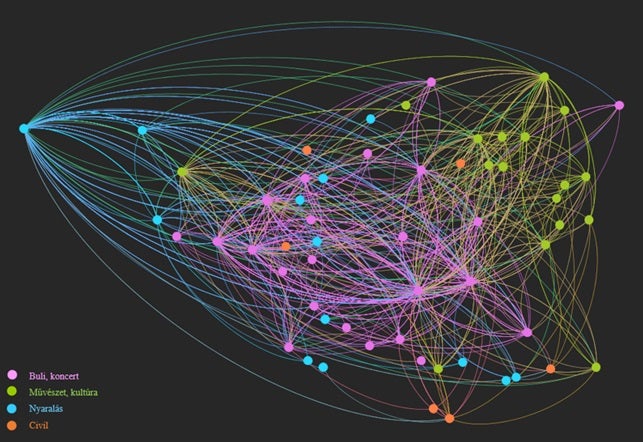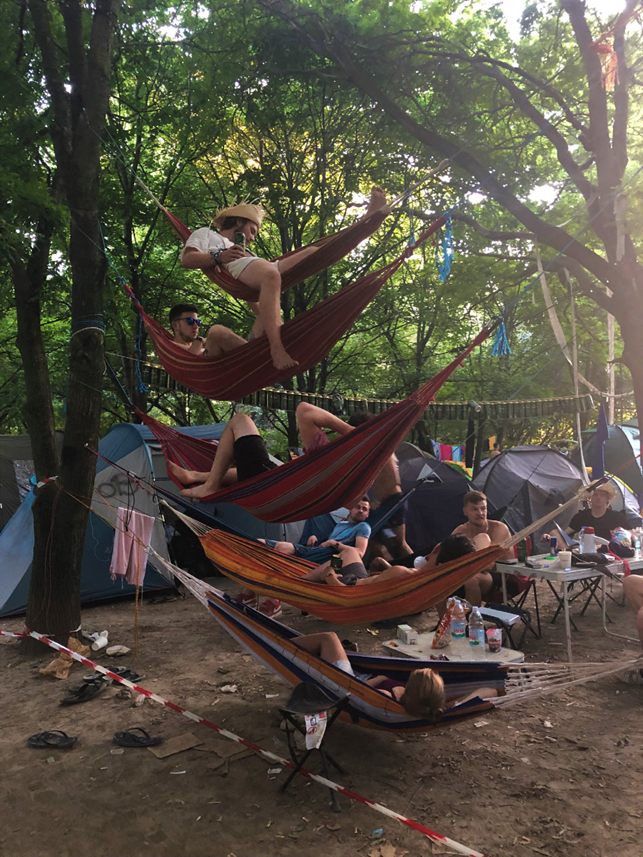The Sziget Festival as we think of it: understanding by mental mapping

Why did you pick the Sziget Festival as your research topic? After all, at the very beginning of your long, multi-year research, you described the festival in your fieldwork journal as “a relatively expensive and nomadic frenzy of unbridled insanity”. But by your third day there, you changed your mind, after a Main Stage concert experience – but not because of the performers. But why?
In the summer of 2014, I applied as a PhD student to get involved in the Sziget research project at the university and was lucky enough to be selected. It was destiny because I didn’t know at the time that this was going to be my doctoral research topic. However, this research project had just begun, that is, when I first participated as a researcher in the festival in its entirety, day and night, for a week, and which then lasted for 6 years (at least the fieldwork part). The first year constituted the foundation of the research parts discussed in the dissertation, when I conducted introspective participant observation and described my assimilation and attitudinal changes at the festival. My most fundamental observation was that the place has a very strong emotional imprint and impact on the people present, and that Sziget has a special atmosphere, defined by many endowments and circumstances, which is difficult to describe but is deeply liveable.
How can an elusive, short-lived terrain be explored as a subject?
This is a very exciting point in the research series, the field and my research questions. You could say it’s a nice research challenge. My scientific interests generally focus on questions that emerge at the boundaries of cultural anthropology, social psychology and sociology: to explore and describe the mental representations of social phenomena that can be observed through the consciousness, perception, attitudes and thoughts of individuals. For example, mental maps or spirit of the place experiences.
One of my main goals in my research at the Sziget Festival was to show how an almost opaque, intermittent and short-lived field can be explored as a subject. The sum of physical and emotional experiences of a place is an impression, often built up from fragments of memories, and thus difficult to uncover. At the same time, there are exploratory-descriptive qualitative methods that can help us learn very important things about these kinds of issues that are relevant to social research. Examples include cultural anthropological participant observation or mental mapping. This trend is also evident in marketing and market research. The bottom-up research strategy is also very important in all this, because it is about letting the researcher blend in the field, so that the questions are real, so that the methods are appropriate to the field, and so that the answers are valid and can be articulated in a meaningful way.

Today, the Sziget Festival is one of Hungary’s most popular events, with a budget of €25 million in recent years and 56-60% of festival-goers from abroad. In 2018, a record 565,000 people took part in the event. The subject has been researched by many people, but has not been addressed in a way as in your dissertation. What was your aim in exploring the mental spaces of the festival? As you write, research into the spirit of place is not at all common in sociology.
My doctoral research deals with the Sziget Festival as a place, the relationship of the festival-goers with the environment (their use of the place, their place constitution, their place interpretation), entitled “Interpreting Sziget Festival as a place”. In other words, the festival is both the object and the field of the research. Although there have been festival research projects and research on Sziget Festival and also research done on the spot (where the primary focus of the research is youth, not the place itself), there has been no social science research on Sziget Festival as a place, environment and the use of space. Previous festival research has not focused on place, space, nor did it use mental mapping.
To put it simply: while the previous or parallel research researched young people at the Sziget, the research presented in this thesis researched the festival through the festival-goers. And it can also be said that research on atmosphere, or rather research aimed at exploring the spirit of a place, is not common. And I could not find any research that used mental mapping to explore the mood of a place. The spirit of the place tends to be associated only with sacred places, perhaps settlements, and its exploration as a lived spatial phenomenon is neglected. The importance of the topic, as well as the application of mental mapping, is being highlighted in many disciplines, and the lack of research and application is also being emphasised.
“Going to the Sziget is not about the concerts and the party, it’s about a specific way of being that is not possible anywhere else,” you write. What does that imply? So what is then the Sziget about, why is it so popular, especially with people in their twenties?
This anthropological observation of mine was mainly based on the specific concert atmosphere. On the one hand, this was due to the concert community as a community of experience, a community of the crowd (not a mass, and not a group) – including the imagined community described by Anderson and the so-called collective experience of Mérei- and the place itself on the other hand. In this concert experience, the focus is no longer on the performers and what they have to say, but on the audience. Not on stage, but on the auditorium. This is a shift towards experiential marketing. In other words, the emphasis is no longer on a product-centric service, but on a more complex experience-centric service.
In the research, you used several methods that have been little known so far, such as mental mapping, experience mapping. How should this be conceived?
Mental mapping is not new or unknown, it is just a less common method or a less standardised area. The research also shows that mental mapping is a very useful method that can be developed and adapted to research questions. As a consequence and as a result of the research work, I applied two self-developed mental mapping methods, which I present in detail in the dissertation. Examples include Experience Mapping and Day Path Mental Mapping.
As you write, the basic mood on the Sziget is one of freedom, friendliness, madness and relaxation. Why are they so important to Sziget goers?
The results show that the Sziget has two main functions and therefore two main atmospheres: partying and holidays. And the experiences reflect these. Some of the festival-goers (mainly returning guests) are typically young foreigners or Hungarians living abroad. They don’t just spend their “party money” here, but also their “holiday money”, which they have saved all year. Some people won’t go anywhere else on holiday, preferring to come here rather than to a beach.
At the Sziget, you can not only listen to concerts, but also “consume” art and culture, and civil society organisations are also present. Yet you see the festival becoming commercialised. Is this normal for an event of this size?
It is not just the size of the event that is making it more and more so, I think, but a more complex process. First of all, Sziget has internationalised (both in terms of festival-goers and performers, and thus in its overall atmosphere). Secondly, it has become increasingly commercialised, which can be seen in its programme offer (“mainstreaming”) and in the rise of sponsors and brands. Thirdly, subcultures that were still visible in the 1990s have disappeared. In other words, instead of alternative group heterogeneities, a more individualised and homogeneous population has emerged, in parallel with improvements in the educational qualifications and financial situation of festival-goers. The proportion of people with a tertiary education or pursuing tertiary studies has increased significantly, and in line with this and internationalisation, their financial situation and purchasing power have also increased, which has facilitated commercialisation. This is also a general trend, as it can be said that popular music (!) festivals are becoming more and more uniform. There is no classical pop culture anymore, no real rebel ideology to create its own musical style, identity and subculture, and festival organisation has become a completely market-oriented genre.
Is there a significant difference between the experiences of Sziget goers, depending on whether they are women or men, Hungarian or foreign?
There are also differences along these lines in the daily route networks, and perhaps the most interesting aspect is the gender difference. Women’s route networks contain fewer typical routes and more individual ones, so the network is more complex and intricate, while men move more deliberately between locations than women. This observation is consistent with movement patterns recorded in supermarkets (in-store), for example on videos for marketing research. This is explained by evolutionary codes, i.e. that it is programmed for men and women: while men “buy”, women “shop”. Women are gatherers, men are hunters. Women therefore tend to be explorers and experience-seekers in shops, while men are simply on a mission and therefore take the short, targeted route.
You currently work as a project leader researcher in market research. Do you plan to continue the Sziget theme? Perhaps with the help of a psychologist, as research often relies on the memories of the participants.
I was planning to, but Covid intervened. Now, from this perspective, it would be interesting to examine whether there is a pre- and post-covid Sziget.

What do you consider to be the main lessons of the research from a scientific point of view, and what practical use can be made of the lessons learned?
There are a number of empirical results from the research that not only help to answer theoretical questions, but can also be used in practice. The results, which are also suitable for this purpose, lead to answers to four theoretical questions relevant to the sociology of space. Here, readers of the interview are invited to check out the dissertation or at least the last chapter, which discusses all this in detail. In summary, the paper highlights gaps and opportunities in both theory and methodology. Overall, the results show that space and society are interrelated, and that space is both a social and a non-social category for social research, with elements beyond human influence. In terms of practical utility, beyond the ability to shape and use mental maps, I would like to highlight from a marketing research point of view that Sziget is an example of how space not only provides a place for an event, but space itself is also a product. The space is not a fenced-off location, but the event itself.
Who were the people who helped you the most in your work at Corvinus?
Many people have been part of my research experience. If I think only of Corvinus and the help I received in my work, I would like to single out László Letenyei, Ariel Mitev and Gábor Michalkó. Fantastic persons and educators.
Katalin Török
Photos and illustrations by Dr. Viktória Pap.